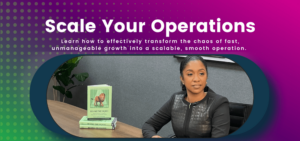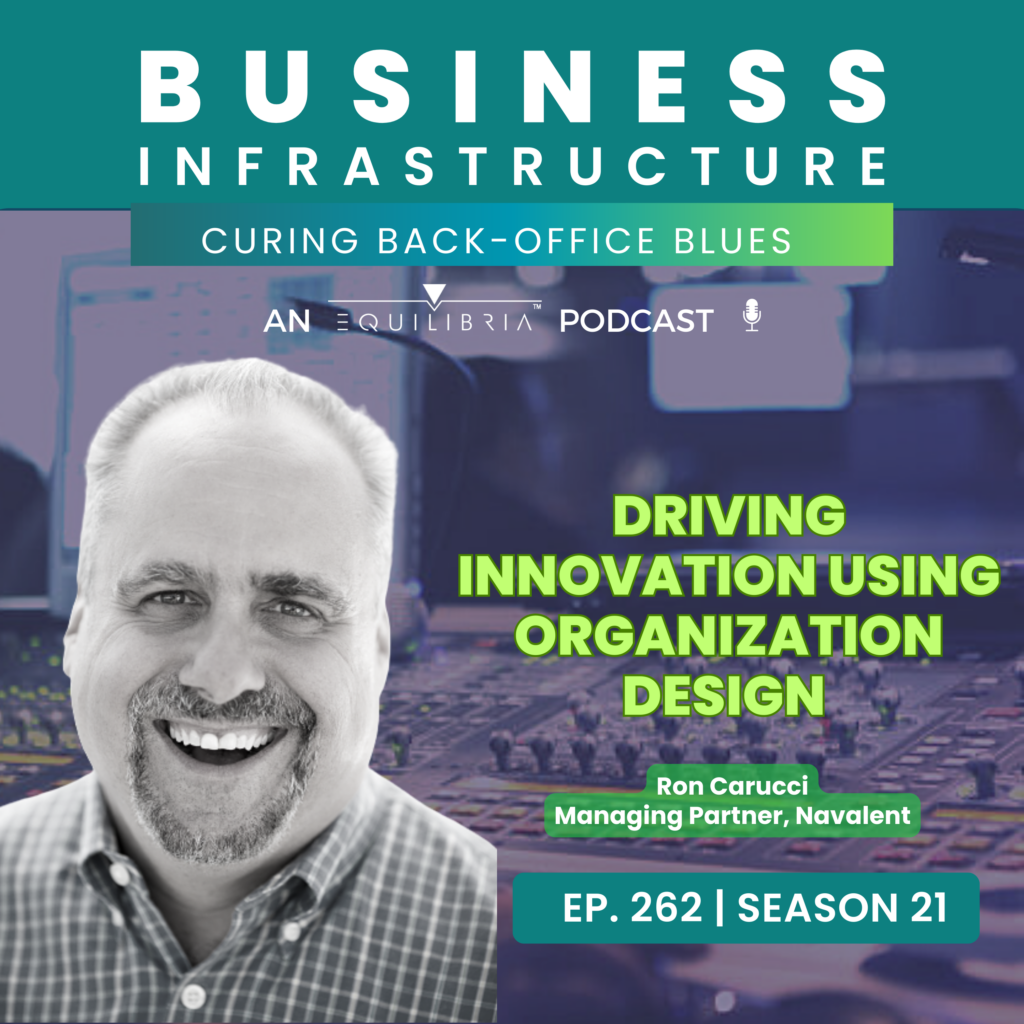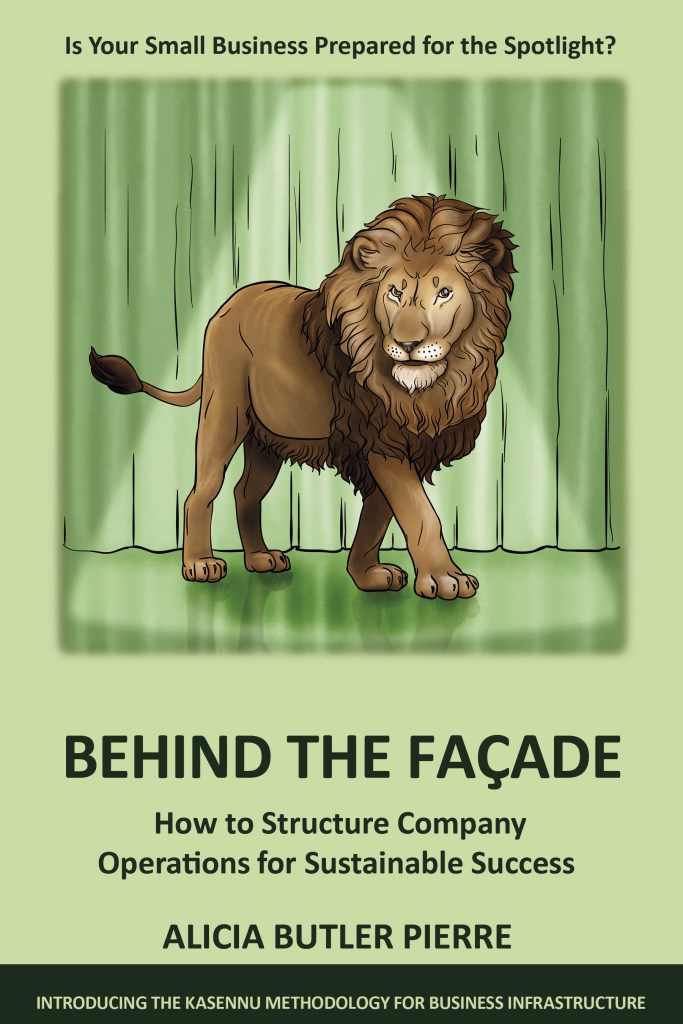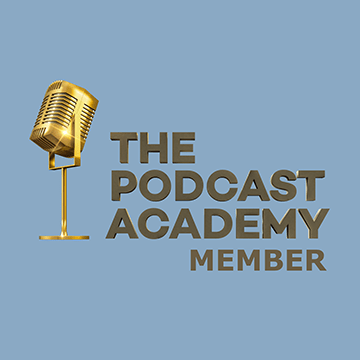Transcript
Hey there! How are you? I’m so glad you could join me as we approach our podcasting vault. I’ve been waiting for you because I’m excited to share with you the next episode we’ve pulled off the shelf. Now, take a seat and put on your headphones. I promise you this oldie but goodie is worth waiting for!
This podcast is brought to you by Equilibria, Inc. We design business infrastructure that frees you from the chaos of fast growth while scaling your operations to the next level.

Welcome to Season 21 of the Business Infrastructure podcast. On this show we share operational tips, strategies, and tactics to help you cure any back-office blues you might be experiencing. I’m Alicia Butler Pierre and this season we’ve decided to remaster some of our most talked about episodes. These are older episodes that we think deserve to go through the rigor of our show’s new format.
And with that being said, our next guest really needs no introduction. He’s going to share with us how he uses organizational design to quickly bring new products to market.
This is Episode 262 – Driving Innovation Using Organization Design with Ron Carucci
In the last remastered episode with Liz Kislik, I hinted that this episode would feature a management “heavyweight.” And you’re about to find out why I say that. Ron Carucci has worked in more than 25 countries on four continents and is the author of eight books! He’s also a regular contributor to the Harvard Business Review. It was a blessing to have Ron join us during the early days of this show and it’s a blessing to now
remaster his original interview. Listen up as he explains more about the work he does at his company, Navalent.

That’s very kind. It’s glad to be here.
We spend our days talking with all kinds of leaders and organizations, mostly leaders who have some strategic aspiration to get somewhere else, or maybe leaders that got themselves stuck in a ditch of some kind. But for some reason, there’s a major change in front of them that they are struggling to get after. And so they call us to help them uncover what could be going wrong and why they might be stuck or why the aspiration they want might be a little bit out of reach, and then how to craft a pathway to get
where they want to go.
Ron’s explanation about what he does seemed broad, so I asked for context.
It could be strategy. Either they don’t have one or they don’t know what it is, or there are too many versions of it.
It could be cultural, where they’ve got behaviors in the organization that they’re not quite understanding why people are choosing to behave the way they are or not choosing to behave the way they want them to. It could be a market shift. A competitor has done something strange or weird or a new regulatory requirement of them, some externally imposed thing. There’s a variety of forces that put pressure on businesses, especially small businesses, where, you know, the owners or founders are typically so busy working in the business that they have no time to work on the business.
And so, the opportunity to scale and really think about the long-term health of the business is often taken away by the fact that they’ve got immediate fires to put out.
Yes. When you mentioned that there’s a major change approaching, do you find that sometimes you actually might suggest the introduction of a new product or a new service for a client like that?
Well, sometimes that is the reason they call. They’ve decided to enter a new market.
Or offer something different to a customer base or try and go after a different customer with what they serve. Now, they’ve made some decisions about their relationship with their marketplace and the customer that they’re trying to execute. A lot of times what we find is that the decision was ill-founded, meaning they made assumptions that were not well founded about their product, or the decision was a good decision to go after a certain customer, but the way they did it didn’t work.

So there’s a variety of problems that can go sideways, and usually, people get very excited about it, especially if they’ve been successful. If you’ve actually got commercialized something very effectively once or twice before, you think you have this halo effect and the market’s rewarding you. So you get careless, you get complacent, you get a little arrogant, and then suddenly you find yourself scratching your head as to why it is now a product isn’t working.
In case you’re wondering, the Halo Effect (according to Oxford Dictionary) is “…the tendency for an impression created in one area to influence opinion in another area.” This can give us a false sense of invincibility when introducing new products or services.
We get ideas, and then we get impulsive or we get reactionary, or we get anxious, and we don’t think about what it means to commercialize something for the long term.
A lot of times, our near-term innovation goals are motivated by we have a hole in our P&L for the year, or we have a region that’s underperforming and so we want to use innovation or product extensions as a way to plug a hole in a financial problem. Sometimes that can work, but a lot of times it’s just masking a problem. And we’re just playing a little bit of a shell game with our products or our services to try and game the marketplace. But people typically see through it and it doesn’t usually go well. Innovation has to be driven by a very clearly identified need that no one else is meeting or that you can meet better than somebody else. We all get wrapped up in our own ideas. We all get enamored with our own creativity and brilliance and assume the rest of the world will follow suit.
But that isn’t always the case. It doesn’t matter what you’re doing out there, someone else is doing it. There may be a lot of people doing it, and they may be right down the street. So these days, to differentiate yourself and your offerings to the people who you want to pay for it really takes a lot of thought and sometimes some luck, but a lot of careful study of the people you want to pay for it, to make sure they, in fact, will pay you for what it is you’re going to bring to market.
To illustrate these points about near-term innovation goals, Ron shared an example.
A beverage company that I work with had been very, very successful in a couple of different categories. The owner of the company and his team were very innovative in flavors, very innovative in packaging, very innovative in how they created their product, and how they brewed their product, how they fermented their products, and how they locally sourced the ingredients. They did some great work in branding and they decided they wanted to enter a third category, having been successful in two others, especially while they’re successful in one of them.
It was a category that was growing. So they should have had their fair share of that growth. But they had major branding issues, and major product quality recall issues, not once, but twice, and admittedly. It was financially motivated, it was not for the love or joy of the product.
And the sad thing is that the category is one they should be in, the category is one that does have room for new entrants and will tolerate innovation and creativity, and they probably could participate very, very well. But they have to go back and redo the steps they skipped in terms of quality, packaging, branding, flavoring, tastes, and really understanding who’s the buyer for this product.
It sounds like Ron’s client fell victim to thinking that if they build it, people will come. The likelihood of that happening is slim to none. Ron warned against this type of thinking.
In many organizations, especially small businesses, when it’s an idea looking for a consumer, people get too Steve Jobs addicted when they think, “Steve Jobs said, ‘Nobody asked for an iPod.’” But yeah, that’s a rare exception, right? For the most part, whether you’re in food and beverage or electronics or apps or some type of professional services or some type of combination of technology and ideas, or personal development, somebody else is likely doing something close to it. And so really finding out what will set
you apart, what the people who you want to pay you really, really want and listening to them and hearing from them how they’re describing the problem.
For small businesses, that’s the most cost-effective way to bring something to market is to make sure you’ve grounded it in the lives and minds of those you want to pay for it, and even so much as making sure you are seen doing that, right? So nothing builds credibility faster for prospective buyers than to see you really care about their needs and wants.
And as Ron alluded to earlier, your potential and existing customers can tell if you truly care about them or whether your company is acting from a place of genuineness. After all, actions always speak louder than words.

Sometimes the relationship between a buyer and seller starts with distrust. Even if I have a legitimately expressed need for something I’m looking for, I’m skeptical. And so I just was on Amazon this morning and I was looking for a particular type of skincare for guys. And of course, if you put that in the search bar, you’ll get ten pages of every type of product there is from prices ranging from twelve dollars to one hundred and eight dollars. And I’m like, how do I pick? These all look like small companies or medium-sized companies. They all look like they have great brands or similar ingredients. On what basis would I choose from the seller who’s sitting somewhere in some town, somewhere in the United States or across the ocean wanting to send me that product? How would I make my decision? And that’s the challenge for small businesses today, is that they’re virtual.
There are so many complex choices for small businesses to make between the time they are commercializing something and the time they’re successful at it. And you just can’t skip those steps. Right? That’s the big challenge. You just can’t skip the process.
You’ve got to be thorough. Thoughtfulness and preparation and data, I think, are the key.
Hmm…thoughtfulness, preparation, and data. In theory, it makes sense, but what about those more famous inventors and innovators who operate by the mantra, “Fail Fast?” How much time should we put into that combination of thoughtfulness, preparation, and data? Does a new product or service have to be completely fleshed out before introducing it to potential customers?
Alicia, I love the question because the other day, a client of mine said that he used the quote, “Perfect is the enemy of good enough.”
And I said, “Yeah, but good enough is the enemy of survival because good enough can often be mediocre.”
So defining honestly, what does good enough really mean? Yes, there are people out there for whom perfectionism is a disease, and it paralyzes them in action because of a fear of failure. That’s an extreme we don’t want to go to. But on the other end trying to fool your customer. Oh, they’ll never know the difference, or It’s good enough, or It’s fine. If you sound like you’re trying to convince yourself that the offering itself will be okay, that should be a red flag.

Because if you don’t know, it means you haven’t actually seen one of your customers use it. You haven’t tested it, you haven’t put it in front of a set of people to say, “Hey, try this. What do you think?” and gotten feedback. Fail fast doesn’t mean spray and pray. Right? Failing fast doesn’t mean crossing your fingers and hoping for the best. It means taking your offering to your target consumer in a controlled, experimental environment and watching them consume it and use it.
Watch them try and wrestle with it. Let them give you feedback. Let them kick the tires on it. Let them criticize it till you want to cry, then go back and refine it, then bring it out again, and maybe by a third time it’s ready for prime time and broad use. Minimal Viable Product doesn’t mean the least you can spend and get away with, right? It means the least you can do that will satisfy your customers in a way they’ll want to pay for it. And those are not the same thing.
And this is where it can get tricky for us small business owners. Cash flow might be stagnant and we’re desperate to resuscitate our business. Maybe new products or services aren’t the solution to providing the air needed. According to Ron, innovation goes beyond offering new products and services.

You know Alicia, there are times when our businesses struggle, right?
So I think it’s a really fair question for a small business owner to say, What can innovation do for me?
I think you can be innovative in how you offer promotions. You can be innovative with how you give stuff away for free, and attract new customers with an option to sample what you offer. So there are ways you can be creative and innovative in how you grow your top-line performance or how you attract customers who don’t know who you are. You just can’t make it a ruse.
You can’t try and sort of create the illusion of a big launch of a new product, but that’s really not one.
Because, again, your customers will call your bluff. This is easy to avoid when you make decisions that are rooted in strategy. Coming up after the break, Ron will share the process he referenced earlier for developing a strategy that includes innovation and…business infrastructure
In the world of business, success isn’t just about great ideas or products. It’s about having a strong foundation—a solid business infrastructure. But why is it so important?
A robust business infrastructure is like the backbone of an organization. It provides the necessary support for all our operations.
Business infrastructure ensures effective communication and collaboration. It allows teams to seamlessly share information, work together efficiently, and make informed decisions.
It also enables efficient data management. With proper systems in place, businesses can securely store, analyze, and utilize their data to gain valuable insights and make strategic decisions.
Thirdly, a strong business infrastructure promotes innovation and growth. It provides the flexibility to scale up operations, adopt new technologies, and adapt to changing market demands. It’s no wonder why a solid business infrastructure is essential for success. It enhances communication, facilitates efficient data management, fosters innovation, and enables flexibility—all vital for businesses to thrive in today’s competitive landscape. Invest in a strong business infrastructure, and watch your business reach new heights!
At Equilibria, we’re excited to offer a free webinar opportunity where we’ll do a deep dive into business infrastructure. Stop being a victim of unmanageable fast growth and start building your own company’s business infrastructure. Don’t wait! Experience the order and calm that thousands of other small businesses have. Sign up now at SmoothOperator.Club. That’s SmoothOperator.club.

We’re back and before the break, Ron Carucci spoke about the challenges of infusing innovation without having a real strategy. Speaking of strategy, do you have one for your small business? If not, then Ron has a process to help you figure that out. Pay close attention as he explains. Here’s Ron.
Whenever I ask a small business owner to tell me their strategy, it’s interesting how many counterfeits I get. I get a mission statement or a vision statement, or I get the product quota, or I get Costco called and placed in order. That’s the strategy. Or I get, this is what the salesperson is selling, that’s my strategy. Or I get the goals for the year, and I tell them, that’s all very interesting, but that doesn’t tell me who you are. Tell me why somebody looking for what you do would pick you over two or three other people who are offering the same thing.
Because if you can’t tell me on what basis you differentiate. Is it service, is it creativity, is its accessibility, is its convenience, is its price, is it depth, and breadth? Is it assortment? There are reasons, especially if you’re in a business that’s rather like you’re in dry cleaning, or you’re in a restaurant, touring, or you sell skincare products. It can be a variety of businesses. But if there are lots of other people doing it, differentiation is that much more important.
Until you tell me what you’re saying no to, you have no strategy.
To recap, step 1 for developing your company’s strategy is understanding your company’s identity. Step 2 of Ron’s process involves looking at your company’s business infrastructure. In other words, the people, the processes, and the tools required to offer your goods and services.
Now we have to step back and look at the work of your organization because so many small businesses get very confused and they want to create a culture of egalitarianism. They want to create a culture where people feel welcomed, and they’re all part of a team. And whether you have 20 employees or 100 employees, the true reality is that not all work is created equal.

Sure, you can treat all people equally, but all of the work you do in your company is not the same. And too many leaders just peanut butter their resources across that work as if it was. So, the tool we use to categorize work separates work into three categories.
The first category is your competitive work. What’s the work you do that directly contributes to those differentiators? In other words, if you invested a dollar in that work, $5 will come in the door. It’s the true secret sauce of your business. It probably accounts for about 15% of your business.
The second category is competitive enabling work. This is the work that directly supports that competitive work. For example, if you’ve chosen to make yourself ubiquitously accessible to all your customers, this could be your website technology to make sure your online store is truly convenient and has a great user experience, and is easily accessible. That’s about another 15% of your work or so.
The rest of the work, 50% to 60% of the work in your organization, is what we call necessary work. It keeps the lights on, it keeps you out of jail. You don’t have to be better out than anybody else and you should do it as cost-effectively as possible. The 30% or 40% of your work that’s competitive or competitive enabling. You should organize that work and invest in that work for maximum impact. The best talent, the best tools, the best technologies, and the rest of it should be for maximum efficiency. The least expensive, the most automated, and the most repeatable.
Now that’s an interesting concept – identifying the work that makes up your business infrastructure, categorizing the work, and then developing a strategy for maximizing the impact vs. the efficiency of that work. Seems practical in concept, but heed Ron’s warning…
The problem is when all that work gets mixed up and when I walk around small businesses, I see people running around with their hair on fire often trying to do all three types of work. Well, of course, what we all know is that the necessary work always wins. It’s more immediate,
It’s more urgent. And so the competitive work and the competitive daily work get put to the wayside, get set aside. I’ll do it later in the week and of course that never comes. And so you dilute your competitive distinctions because you haven’t organized the work well.
So the first thing to do is have set your identity, having set your strategic clarity about who you want to be and who you want to serve, and how you’re going to do it, you have to organize the work accordingly.
And those are the two very common processes that small businesses are so reticent to duplicate because they’re too busy. And then the problem, of course, is one of the greatest impediments to that is success.
And this is a precarious, and dare I say, dangerous place to be. It’s a place we emphasize on this show – being a victim of your own success without the business infrastructure to support high demand and fast growth.

So if you’ve been successful, if the marketplace has rewarded you and you have had a tailwind behind you, and suddenly you went from being a $10 million company to a $30 million company or a $50 million company to an $80 million company. But really what you are is an $80 million company trapped in the body of a $10 million organization.
You grew but you didn’t scale. And now it’s mayhem. And you can walk into those places. You can just hear the seams ripping as people are stretched too thin and confused. And the priorities change every day. And they don’t know who gets to make what decision. And they’re frustrated.
And that frustration and chaos can lead to irreparable damage.
You as a business owner or a team of people who own the business are thrilled because it looks like success. But it’s really masking the fact that you don’t really have a sustainable business. And once you hit a headwind or once this wave crests of success, you might find yourself in more trouble than you think.
I’ll go ahead and boldly shout out my book. It’s called Behind the Façade: How to Structure Company Operations for Sustainable Success. And I agree with Ron 100% – the façade, or the mask as he calls it, has us and our customers believing in our success until that mask comes off and the ugly truth of chaos, disorder, and mayhem is revealed. That’s why business infrastructure matters. It’s a system for linking your people, processes, tools, and technologies so that scale happens in a sustainable, repeatable, and profitable way.

The word I love that you use, Alicia, is the word, “system.” I wish your listeners could hear nothing else from you hear the word. It is a system. It’s not QuickBooks over here and PayDay over here.
If you don’t have an integrated system of how all your data talks to each other, and how all of your people understand the end-to-end way you make money, you’re already behind.
Based on all of this, I was curious about what happened to Ron’s client that he talked about before the commercial break. What’s one lesson that stood out for him?
Well, it’s the greed, one. Many businesses aspire to sell, right? They want an exit strategy of some kind, and sometimes they’re successful and they come along, get sold, and they’re now part of someone else’s portfolio of company, but you have to stick around for four or five years to be part of it. Well, the problem is your payout. It’s going to be based on hitting certain milestones financially. And EBITDA is often one of the metrics that buyers will use to determine your upside. Well, I’ve never seen an acquisition or a merger in my career where the owner who sold and had a stay didn’t become EBITDA-addicted.
And you will just make very short-term decisions on cost structure. And this is true as you prepare to sell too. You’ll start gutting costs and gutting. You want your balance sheets to look attractive. You want your sales to look attractive. So you start jerry-rigging things and compromising who you are just to become attractive to a suitor or to maximize your upside after you found a suitor. And I would just say it never works.
It doesn’t. And this idea of being EBITDA addicted. I’ll tell you why that stands out to me, because one thing that I’ve noticed, especially when I’m in a room with corporate C-level executives, is it’s almost like they’re speaking another language because it’s always about EBITDA. It’s always about the numbers. And very rarely is there ever any type of conversation around the operations, making sure that the work that you’re doing and the products and services that you’re creating and delivering are actually meeting the promises that you’ve made to your customers.
So I’d like for you to talk about that just a little bit more because it’s something that I’ve seen. And yes, the numbers are important, but if we aren’t careful, it can also lead us to, as you said, make these short-term decisions and might even lead to us compromising our values.
Oh, my gosh, I have a big grin on my face here Alicia. You and I have seen this movie 100 times, haven’t we?
Yes.
And the good news is I have been in boardrooms and executive team rooms where that is not the conversation, where there is a conversation about the customer and the culture and the talent and the financials. Right? So there’s a balanced dashboard of what we’re measuring to determine whether or not we’re performing as we want to. It’s not just about the numbers, but when you have a VC in the room or a PE firm in the room or you’re trying to get them in the room or you’re struggling. It’s very easy to pull the financial metric lever aggressively at the expense of other things. And yes, that does begin often a slow death or sometimes a fast death spiral.
I tell businesses, put pictures of your target market in your office, all over the place. Have their names, and have real customers if you can. If you’re B2B, get pictures of the company logos, but make sure the center of gravity for everything you do, remains rooted outside your walls. The minute the center of gravity, the thing that primarily draws the attention of the organization, shifts inside, that’s stage one cancer.
As you can tell, Ron is a wealth of information and it’s impossible for us to capture everything he has and wants to share in this episode. So, with that in mind, one of the first places where you can access some of his additional resources is his company’s website – Navalent.com. There you’ll find a set of organization design tools you can download. Additionally, Ron has some other resources to share.
We have our free e-book on leading change and how we think about the change in an organization and how it matures. If you come to Navalent.com/transformation, you can get that free e-book. We’ve also got some great videos. So if you go on there and look at organization design, a whole bunch of stuff comes up, including the categorization of your work.
Ron has also written several books and at the time of the original recording of this interview in 2019, he shared information about his latest book.
Yeah. So, the last book, Rising to Power, was a ten-year study of leaders. For many leaders, as they rise up, as their businesses grow, as their career grows and they get more and more influence, we’ve known for a long time that more than half of them fail in the first 18 months of taking on more responsibility or bigger influence.
And as leaders go from working, being in their garage, making their product, to leading an organization of people making their product, it can be very disorienting. And for some, it’s a very difficult transition. And we thought we can do better. We don’t have to have half of them fail. We studied more than 2700 leaders to understand,
How do you rise up and stick to the landing? How do you make your way to leading an organization, leading a team, and doing it effectively? And so Rising to Power is our playbook for how you do that.
Be sure to check out Rising to Power as well as Ron’s other books and his extensive contributions to the Harvard Business Review. Unfortunately, we have to wrap up with Ron. I can’t thank him enough for imparting his wisdom and years of management experience with us!
Alicia, it was my pleasure. Thanks so much for having me. And I wish you all the best. As you help the small businesses in your world get better, I’m sure that they’re all grateful to have you in their corner.
Well, that’s awfully kind of you, Ron. Let’s give a round of applause for him. By now I’m sure you understand why I referred to Ron at the beginning of this episode as a management consulting heavyweight.
You can access all the resources Ron mentioned at BusinessInfrastructure.TV. Again, that’s BusinessInfrastructure.TV.
Thank you for listening! If you enjoyed this episode, then please subscribe and leave a five-star rating and review.

For now, I’m closing the vault until it’s time to feature our next remastered episode. Stay tuned because it will take us to Hong Kong where we’ll hear from an expert on the future of work who also happens to be a pricing guru.

As always, remember to stay focused and be encouraged. This entrepreneurial journey is a marathon and not a sprint.
This podcast was written, produced, and narrated by me, Alicia Butler Pierre. Audio editing by Olanrewaju Adeyemo. The original score and sound design by Sabor! Music Enterprises.
This is the Business Infrastructure – Curing Back-Office Blues podcast.





















